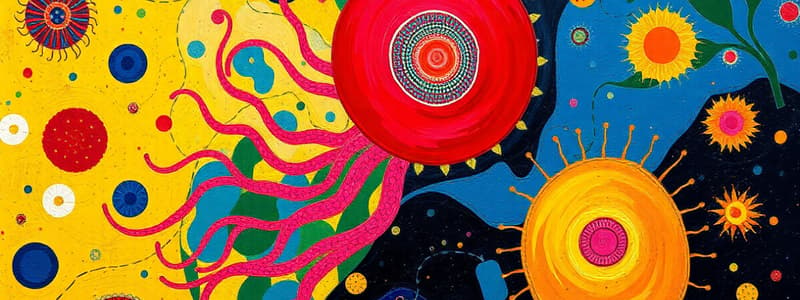Podcast
Questions and Answers
What are protists?
What are protists?
Eukaryotic organisms, mostly unicellular, some multicellular and are endosymbiotic. They are NOT bacteria.
Which of the following are characteristics of eukaryotic organisms?
Which of the following are characteristics of eukaryotic organisms?
- They have membrane-bound organelles. (correct)
- They are all multicellular.
- They are all photosynthetic.
- They have a nucleus. (correct)
What type of organisms perform photosynthesis using chloroplasts?
What type of organisms perform photosynthesis using chloroplasts?
- Chemoheterotrophs
- Photoautotrophs (correct)
- Mixotrophs
- All of the above
What are chemoheterotrophs?
What are chemoheterotrophs?
What are mixotrophs?
What are mixotrophs?
What is endosymbiosis?
What is endosymbiosis?
What are the four protist groups?
What are the four protist groups?
What is a characteristic feature of Excavata protists?
What is a characteristic feature of Excavata protists?
Which of the following are types of Excavata protists?
Which of the following are types of Excavata protists?
What are diplomonads?
What are diplomonads?
What is Giardia intestinalis?
What is Giardia intestinalis?
What are parabasalids?
What are parabasalids?
What is Trichomonas vaginalis?
What is Trichomonas vaginalis?
What are euglenozoans?
What are euglenozoans?
What is trypanosoma?
What is trypanosoma?
What does SAR stand for?
What does SAR stand for?
What are Stramenopiles?
What are Stramenopiles?
Which of the following are groups of Stramenopiles?
Which of the following are groups of Stramenopiles?
What are diatoms?
What are diatoms?
How do diatoms affect the carbon level in water?
How do diatoms affect the carbon level in water?
What are golden algae?
What are golden algae?
What are alveolates?
What are alveolates?
Which of the following are types of alveolates?
Which of the following are types of alveolates?
What are dinoflagellates?
What are dinoflagellates?
What is the significance of dinoflagellates in the environment?
What is the significance of dinoflagellates in the environment?
What are apicomplexans?
What are apicomplexans?
What is plasmodium?
What is plasmodium?
What is alternation of generations?
What is alternation of generations?
Flashcards
Protists
Protists
Eukaryotic organisms, mostly unicellular, some multicellular and are endosymbiotic. NOT bacteria.
Eukaryotic organisms
Eukaryotic organisms
Organisms with a nucleus and membrane-bound organelles.
Photoautotrophs
Photoautotrophs
Organisms that perform photosynthesis using chloroplasts.
Chemoheterotrophs
Chemoheterotrophs
Signup and view all the flashcards
Mixotrophs
Mixotrophs
Signup and view all the flashcards
Endosymbiosis
Endosymbiosis
Signup and view all the flashcards
Excavata
Excavata
Signup and view all the flashcards
Diplomonads
Diplomonads
Signup and view all the flashcards
Giardia intestinalis
Giardia intestinalis
Signup and view all the flashcards
Parabasalids
Parabasalids
Signup and view all the flashcards
Trichomonas vaginalis
Trichomonas vaginalis
Signup and view all the flashcards
Euglenozoans
Euglenozoans
Signup and view all the flashcards
trypanosoma
trypanosoma
Signup and view all the flashcards
SAR
SAR
Signup and view all the flashcards
Stramenopiles
Stramenopiles
Signup and view all the flashcards
Diatoms
Diatoms
Signup and view all the flashcards
Golden algae
Golden algae
Signup and view all the flashcards
Brown algae
Brown algae
Signup and view all the flashcards
Alveolates
Alveolates
Signup and view all the flashcards
Dinoflagellates
Dinoflagellates
Signup and view all the flashcards
Apicomplexans
Apicomplexans
Signup and view all the flashcards
plasmodium
plasmodium
Signup and view all the flashcards
Ciliates
Ciliates
Signup and view all the flashcards
paramecium
paramecium
Signup and view all the flashcards
Alternation of generations
Alternation of generations
Signup and view all the flashcards
Micronuclei
Micronuclei
Signup and view all the flashcards
Macronuclei
Macronuclei
Signup and view all the flashcards
Binary fission
Binary fission
Signup and view all the flashcards
Rhizarians
Rhizarians
Signup and view all the flashcards
Pseudopodia
Pseudopodia
Signup and view all the flashcards
Radiolarians
Radiolarians
Signup and view all the flashcards
Forams
Forams
Signup and view all the flashcards
Tests
Tests
Signup and view all the flashcards
Archaeplastida
Archaeplastida
Signup and view all the flashcards
Red Algae (Rhodophytes)
Red Algae (Rhodophytes)
Signup and view all the flashcards
Phycoerythrin
Phycoerythrin
Signup and view all the flashcards
Porphyra
Porphyra
Signup and view all the flashcards
green algae
green algae
Signup and view all the flashcards
Charophytes
Charophytes
Signup and view all the flashcards
Chlorophytes
Chlorophytes
Signup and view all the flashcards
unikonta
unikonta
Signup and view all the flashcards
Amoebozoans
Amoebozoans
Signup and view all the flashcards
Mycetozoa
Mycetozoa
Signup and view all the flashcards
Plasmodial slime molds
Plasmodial slime molds
Signup and view all the flashcards
Opisthokonts
Opisthokonts
Signup and view all the flashcards
Study Notes
Protists
- Eukaryotic organisms, primarily unicellular, some multicellular.
- Not bacteria.
- Endosymbiotic in some cases.
- Four main groups: Excavata, SAR, Archaeplastida, Unikonta.
Excavata
- Protists with an "excavated" feeding groove.
- Reduced mitochondria (rely more on anaerobic respiration).
- Often inhabit anaerobic environments.
- Unique flagella for movement and potentially predation.
- Three subgroups: Diplomonads, Parabasalids, Euglenozoans.
Diplomonads
- Parasitic protists.
- Reduced mitochondria (mitosomes).
- Two identical nuclei and multiple flagella.
- Gain energy through anaerobic pathways.
- Giardia intestinalis: causes intestinal infections in mammals.
Parabasalids
- Parasitic protists.
- Contain hydrogenosomes (modified mitochondria).
- Release hydrogen as a byproduct of anaerobic respiration.
- Trichomonas vaginalis: sexually transmitted disease affecting the reproductive and urinary tracts.
Euglenozoans
- Diverse group featuring parasitic (predatory), photosynthetic, and mixotrophic species.
- Unique rod and spiral crystalline structure within flagella.
- Trypanosoma: causes sleeping sickness (kinetoplastid).
SAR
- Stramenopiles, Alveolates, Rhizarians.
Stramenopiles
- "Hairy flagella" (two flagella; one smooth, one hairy).
- Includes algae.
- Three groups: Diatoms, Golden Algae, Brown Algae.
Diatoms
- Unicellular algae.
- Photosynthetic.
- Glass-like silica cell walls (frustules).
- Crucial to aquatic carbon cycling.
Golden Algae
- Unicellular algae.
- Yellow and brown carotenoids.
- Photosynthetic and mixotrophic.
- Two flagella.
Brown Algae
- Multicellular marine algae.
- Abundant in temperate coastal waters with cold currents.
- Reproduce via alternation of generations.
- Include brown seaweeds.
Alveolates
- Membrane-enclosed sacs (alveoli) under the plasma membrane.
- Photosynthetic and heterotrophic.
- Three main types: Dinoflagellates, Ciliates, Apicomplexans.
Dinoflagellates
- Two flagella in grooves, reinforced by cellulose plates.
- Primarily heterotrophic, some photosynthetic, or mixotrophic.
- Harmful algal blooms (HABs) can result in toxins that kill fish & invertebrates. These toxins can also affect humans, who eat fish/shellfish with blooms.
Apicomplexans
- Parasitic protists (animals).
- Specialized organelles for penetrating host cells (apical complex).
- Apicoplasts (modified plastids).
- Complex life cycles, often involving multiple host species.
- Plasmodium: causes malaria.
Ciliates
- Movement and feeding via cilia.
- Primarily predators (bacteria & other protists).
- Two types of nuclei: Macronuclei (everyday functions) and Micronuclei (genetic exchange).
- Reproduce via binary fission and conjugation (sexual exchange).
- Paramecium: common freshwater ciliate.
Rhizarians
- Amoebas with threadlike pseudopodia.
- Two subgroups: Radiolarians and Foraminiferans.
Radiolarians
- Amoebas with intricate silica skeletons.
- Microtubules reinforce pseudopodia.
Foraminiferans
- Amoebas with porous calcium carbonate shells (tests).
- Pseudopodia extend through pores.
- Important in marine environments.
Archaeplastida
- Includes red algae and green algae.
Red Algae (Rhodophytes)
- Phycoerythrin pigment masks chlorophyll, making them appear reddish (or purplish).
- Important in warm coastal waters.
- Multicellular, sometimes large.
- No flagellated gametes, relying on water currents for fertilization.
- Porphyra: nori used in sushi.
Green Algae
- Chloroplasts and cell structure similar to plants.
- Diverse, mostly freshwater, but some marine.
- Two subgroups: Charophytes and Chlorophytes.
Charophytes
- Most closely related to plants.
Chlorophytes
- Predominantly freshwater, though some marine.
- Diverse in forms (unicellular).
Unikonta
- Protists most closely related to fungi and animals.
- Two subgroups: Amoebozoans and Opisthokonts.
Amoebozoans
- Amoebas with lobed pseudopodia.
- Include slime molds (Mycetozoa).
Mycetozoa (Slime Molds)
- Single mass of cytoplasm, multinucleate.
- Expand by phagocytosis using pseudopodia.
- Form fruiting bodies for (sexual) spore production.
Opisthokonts
- Diverse group related to fungi and animals.
Protist Environmental Roles
- Many are crucial for aquatic ecosystems.
- Some are mutualistic.
- Photosynthetic protists are foundational producers in aquatic ecosystems.
- Some are parasitic, causing diseases (malaria).
Fungi
- Eukaryotic organisms, essential decomposers.
- Mostly multicellular, sometimes unicellular (yeasts).
- Heterotrophic, absorbing nutrients from surroundings.
Fungal Nutrition
- Secrete hydrolytic enzymes which break down complex organic compounds, facilitating nutrient absorption.
Fungal Morphology
- Consist of hyphae (filaments) creating a mycelium (network).
- Cell walls strengthened by chitin.
Fungal Hyphae
- Tubular cell walls surrounding plasma membrane and cytoplasm.
- May have septa (cross-walls), or be coenocytic.
Mycelium
- Network of hyphae.
- Maximizes surface-to-volume ratio (efficient absorption).
Specialized Hyphae
- Haustoria: penetrate plant cells for nutrient absorption.
- Arbuscules: enhance nutrient exchange in mycorrhizae.
Mycorrhizae
- Mutualistic relationships between fungi and plant roots.
Spores
- Reproductive units for dispersal (air and water).
Fungal Reproduction
- Asexual (spores by mitosis) and Sexual Reproduction (meiosis).
Fungal Sexual Reproduction
- Hyphae of different mating types fuse (plasmogamy).
- Nuclei fuse (karyogamy).
- Meiosis to create haploid spores.
Asexual Reproduction
- Spores produced via mitosis.
- Molds (filamentous, fast-growing).
- Yeasts (single-celled, common form of reproduction is budding).
Different Phyla of Fungi
- Chytridiomycota (some flagellated spores, decomposers/parasites/mutualists)
- Zygomycota (fast-growing molds, many are decomposers)
- Glomeromycota (form arbuscular mycorrhizae)
- Ascomycota (diverse group, including yeasts and morels)
- Basidiomycota (club fungi, including mushrooms, puffballs)
Studying That Suits You
Use AI to generate personalized quizzes and flashcards to suit your learning preferences.


